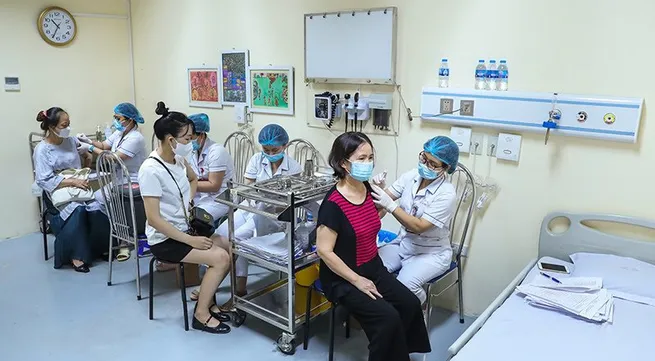Finding way to solve vaccine problem

Therefore, from the end of 2020 and especially in the first quarter of 2021, countries ordered manufacturers to produce a large amount of vaccines. Thanks to early and large orders, the rate of COVID-19 vaccination in Europe and Americas is the highest in the world.
The percentage of people who have received the full dose of Covid-19 vaccine (two doses) in Europe is 25.8% of the population, this rate in Northern America is 32.87%, while in Asia it is 8.22%. In the ASEAN region, Singapore has the highest rate of full-dose injection at 35.8%, followed by Cambodia at 18.24%, 8 out of the 10 remaining countries with a rate not exceeding 8%.
Vietnam is the only country where less than 1% of the population has received a full dose of vaccine. On average, as of June 30, 2021, 11.04% of the population had received a full dose of vaccine. Some countries have a high rate of vaccination for people such as the US (46.61%), the UK (48.68%), Mongolia (53.39%) and Israel (57.2%).
Analysis of the number of countries that have ordered the production of Covid-19 vaccines shows a very disproportionate distribution to the global population of the current vaccine production supply. While the number of vaccines administered worldwide is equivalent to 34.71% of the world population, (11.04% of the population has received two doses; while 12.63% of the population has received one dose), the number of vaccines the UK has ordered for production is 517 million doses, equal to 755% of the population.
This means that on average, the UK's government ordered 7.55 doses per citizen. Meanwhile, 7.65 doses were ordered per resident in Canada, 3.95 doses in the US, 5 doses in the European Union (EU), 4.5 doses in Japan and Australia, 3.07 doses in Israel, 2.18 doses in the Republic of Korea (ROK), and 2.1 doses in Brazil.
The Covax Mechanism also ordered 1.55 billion doses and the African Union ordered 670 million doses. A total of 47 countries (which have publicly announced the number of vaccines they ordered); Covax and the African Union have ordered production of 9.312 billion doses.
In fact, as of June 30, 2021, more than 3.12 billion doses of vaccine have been produced and distributed worldwide, fulfilling only about one-third of all orders. According to experts' forecasts, by September 2021, the world can produce 5 billion doses of vaccine, still 4.3 billion doses short of the ordered number. It can be estimated that by December 15, 2021, the world will have produced about 6.5 billion doses of vaccine, still short about 2.8 billion doses compared to the number ordered by 47 countries, Covax and the African Union. As such, other countries that have placed orders late will find it very difficult to receive their vaccines by the deadline stated in the contract.
The question is if the countries that ordered early receive enough vaccines, what is their real need? How many doses of vaccine will they have left over, and not used this year?
If it is estimated that in 2021, the 32 countries with the largest vaccine hoard will have enough vaccinations for 70% of their population (two doses per person) and two doses per person in reserve for 2022, meaning that each person can be guaranteed four doses in 2021. Thus, they will need 3.003 billion doses, while they have ordered 5.012 billion doses. That is, with the total population of these 32 countries at 1.036 billion people, they cannot use all of the 5.012 billion doses, but will have 2.009 billion left over.
Vietnam is facing its fourth wave of the COVID-19 epidemic. Although it has not yet reached the peak, this is the longest and heaviest wave so far. In the context of the Covid-19 pandemic continuing to be complicated, in order to achieve herd immunity, it is necessary to use vaccines to strongly and quickly prevent infection in the six current hotspots, then in 45 provinces and cities where the epidemic is spreading, and finally in the 12 localities without epidemic.
With the goal of vaccinating about 70 million people, it is necessary to inject 68.32 million people, with a total of 136.64 million doses (two doses per person). To date, Vietnam has signed contracts with partners to buy or supply Vietnam with 110 million doses of vaccines, but most of these producers will not be sanctioned if they do not deliver at the scheduled delivery time as stated in the contract.
So far, it is not possible to know exactly when 110 million doses of this vaccine will arrive to Vietnam. Up to now, Vietnam has injected about 3.8 million doses out of a total of 4.9 million doses received. Of which, the number of people who have received one dose is about 3.5% of the population; and the number who have received two doses is about 0.2% of the population. Thus, compared to the world's average vaccination rate, Vietnam's vaccination rate is among the very lowest and is indded the lowest in ASEAN. Compared to the requirement that 70% of the population receive two vaccine doses in 2021, the current rate in Vietnam is too low.
Thus, the problem is how to get about 100 million vaccine doses in the next two to four months, and 30 million more doses in the last two months of the year, to achieve the goal of vaccinating 70 % of the population, achieving herd immunity. From current practice, it is necessary to find a vaccine source that can be purchased quickly or swapped, and then return them a new vaccine ordered delivered later. Through the above analysis, the real demand of 32 countries, which have ordered 5.012 billion doses for 2021 (including reserves for 2022), is only 3.003 billion doses; a 2.009 billion dose excess.
Therefore, if Vietnam negotiates with the leaders of the EU (27 countries) and the governments of the UK, the US, Canada, Australia and Japan to buy back or swap new vaccines , we can quickly get about 100 to 130 million doses. The EU and these five countries both have a comprehensive cooperative partnership or strategic partnership with Vietnam. The acquisition or partial swap of the vaccine would be considered beneficial for both parties.





